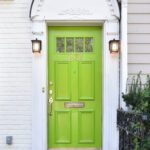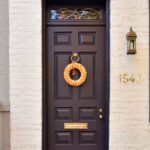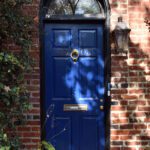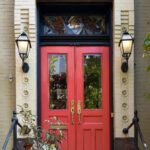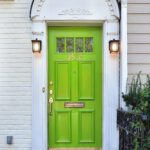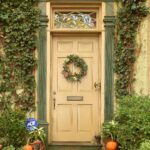At Home: The Door
By • March 13, 2024 0 445

The door, as an architectural element, has saturated our psyches and language so fully that we barely notice it. Yet opening a door to reveal the space beyond it is pivotal to our sense of privacy and propriety. The interior door helps us move between spaces in our homes and is the junction of the public and the private realms. Doors between the outside world and the sanctity within welcome family and friends and shield us from enemies.
When America was being settled by Europeans in the late 1600s, the simple design of the plank door offered protection from the elements and from intruders. Much like the early front doors, the interior doors were also plank doors, known as board and batten. The door itself, as well as the hinges and operating hardware, were fabricated from wood.
Although the board and batten door design endured in mostly rural areas, American residential architecture evolved in more populous towns. Between 1750 and 1840, architectural design generally exhibited one of three recognizable styles: Georgian, Federal and Greek Revival. And although the style elements varied, they spoke a common language.
“Almost every decorative element has its origins in classical architecture,” said Craig Weis, founder and president of Architectural Woodcraft in Asheville, North Carolina, “notably the raised-panel door, and strict symmetry is common to all three of these foundational styles.”
And yes, sometimes features from one style overlap with those of another. In the 1830s, woodworking machines had already changed the way that doors were made and assembled. By the late 19th century, catalogs were selling a large selection of manufactured doors to a rapidly expanding population.
Both exterior and interior doors shared some design attributes. However, interior doors tended to be made of thinner wood and, since they could not accommodate a doorknob assembly, most early interior doors had thumb latches. In the United States, interior residential doors were generally thin in construction until the 1840s, with some thicker doors being found in later 19th-century homes.
Even though the basics remained the same, increased technology made it possible to embellish a door, which led to more elaborate door designs, as in the Greek Revival style. This style incorporated elaborate molding designs that were often nailed on — a layering of panel within panel with moldings applied at each margin, which could be three or four inches thick.
The Victorians, proponents of copious decoration on almost everything, employed even more machine-made door ornaments. Intricate door designs proliferated. Stained and etched glass were Victorian innovations. Initially, only the two upper panels were glazed, but by the 1880s the entire top half of a door might include leaded panes and patterned, colored stained glass. During this era, roughly from 1840 to 1901, many doors still had fanlights, typical in the traditional Georgian style, but the Victorians added intricate ironwork designs, as well as brighter door colors.
Later on, a simpler door design was introduced. Almost medieval in appearance and proportions, yet modern in construction, the Arts & Crafts door became a key element in the new wave of bungalows, Foursquares and Prairie School-inspired houses popping up across the country at the turn of the 20th century and into the 1920s.
Style has constantly changed, and material trends have shifted through the eras, mainly influenced by cost. Even though many people choose wood doors for their beauty, insulated doors of fiberglass and steel — popular materials for use in the construction of entry doors — are energy-efficient. Plastic doors and composite interior doors enjoyed a boom in the early 2000s, due to their perceived low maintenance and affordability. But despite radical changes in building technology over the centuries, wood has remained the primary building material for doors.
Today, even interior doors are mostly made from wood, since wood offers improved thermal efficiency. The cellular structure of wood is a natural insulator (400 times more efficient than steel) and is more dimensionally stable than other materials. And as the world becomes more aware of climate change, the sustainability of wood is another draw for the environmentally conscious.
But, as with any material, there are limitations to wood doors. They are not maintenance-free. To preserve a good finish, wood doors cannot withstand complete and constant exposure to full sun; porches and hoods help shield them from the elements.
“Few pursuits are as satisfying as gathering high-quality raw materials and fashioning them into works of lasting beauty,” said Weis. “We use the best woods to handbuild thousands of beautiful entrance and interior doors and finish each door to provide many lifetimes of use.”
Door security has come a long way from the simple wood plank that kept out trespassers. One of the first serious attempts to improve the security of the entrance door was made in England in 1778 by Robert Barron, who patented a double-acting tumbler lock. By the 19th century, the Industrial Revolution was well underway, and the production of metal and metal parts stimulated the growth of more secure locks. However, after World War I, some people still eschewed technological innovations and employed a door shaker to come around after dark to ensure that their homes were locked up.
Even through innumerable improvements and iterations to entrance door security — like Marie Van Brittan Brown’s invention of the first video monitoring and remote door operating system in the 1960s — the basic principles of the door lock remain today. There are 21 types of locks used today, ranging from the padlock to the deadbolt, and each serves a very useful purpose, even though the materials and designs have evolved to be more streamlined.
The journey of doors from a simple barrier to a sophisticated, multifunctional element of our homes is a testament to human innovation and creativity. Even though we may never know who invented the door, we can appreciate the evolution of this quotidian invention that has enriched our everyday lives in so many ways.
See below for a gallery of doors around town. Photos by Greg “Fritz” Blakey.
Michelle Galler is a Realtor with Chatel Real Estate, representing buyers and sellers in both Washington, D.C., and Virginia with in-town, as well as rural, real estate assistance. She is also an antiques dealer and a columnist.
- The front door of Call Your Mother Deli in Georgetown.


